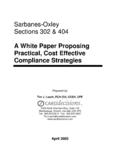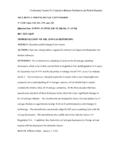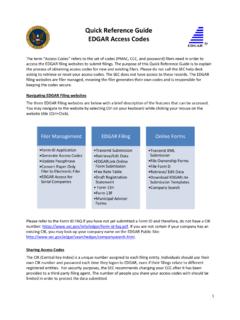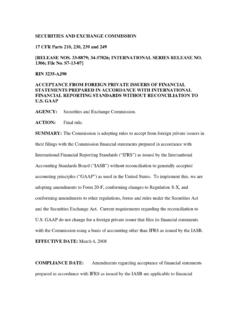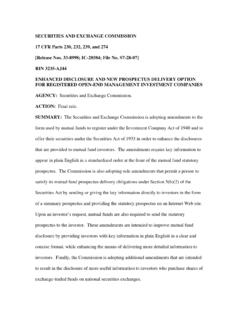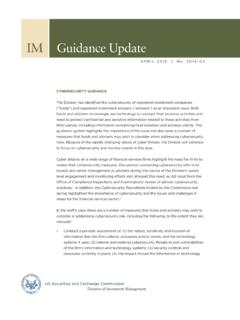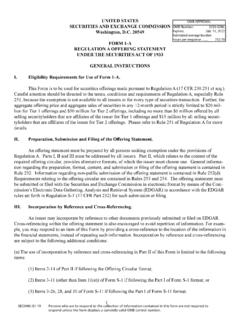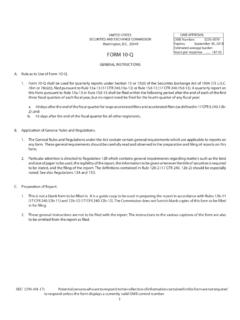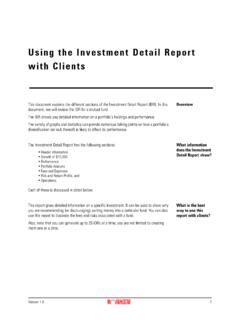Transcription of Report to Congress on Algorithmic Trading - SEC
1 1 Staff Report on Algorithmic Trading in Capital Markets As Required by Section 502 of the Economic Growth, Regulatory Relief, and Consumer Protection Act of 2018 This is a Report by the Staff of the Securities and Exchange Commission. The Commission has expressed no view regarding the analysis, findings, or conclusions contained herein. August 5 , 2020 2 Table of Contents I. Introduction .. 3 A. Congressional Mandate .. 3 B. Overview .. 4 C. Algorithmic Trading and Markets .. 5 II. Overview of Equity Market Structure .. 7 A. Trading Centers .. 9 B. Market Data.
2 19 III. Overview of Debt Market Structure .. 23 A. Types of Debt Securities or Instruments .. 23 B. Data and Communications .. 28 IV. Benefits and Risks of Algorithmic Trading in Equities .. 30 A. Investors .. 30 B. Brokers .. 36 C. Principal Trading .. 37 D. Operational Risks to Firms and the Market .. 42 E. Studies of Effects on Market Quality and Provision of Liquidity .. 44 F. Effects of the COVID-19 Pandemic .. 47 V. Benefits and Risks of Algorithmic Trading in Corporate and Municipal 51 A. Liquidity Search and Trade Execution .. 51 B. ETF Market Making and Arbitrage .. 53 C. Studies of Effects on Market Quality and Provision of Liquidity.
3 53 VI. Regulatory Responses to Market Complexity, Volatility, and Instability .. 55 A. Improving Market 55 B. Mitigating Price Volatility .. 60 C. Facilitating Market Stability and Security .. 63 D. Additional Ongoing and Potential Commission and Staff Actions .. 67 VII. Summary of Studies on Algorithmic Trading .. 69 A. Equities .. 69 B. Debt Securities .. 82 VIII. Conclusion .. 83 IX. Bibliography to Summary of Academic Studies .. 85 X. Appendix: Market Participants, Roles, and Obligations .. 92 3 I. Introduction A. Congressional Mandate The Economic Growth, Regulatory Relief, and Consumer Protection Act of 2018 requires the staff of the Securities and Exchange Commission (the SEC or Commission ) to submit to Congress a Report on the risks and benefits of Algorithmic Trading in the capital Specifically, 502 provides: (a) In General.
4 Not later than 18 months after the date of enactment of this Act, the staff of the Securities and Exchange Commission shall submit to the Committee on Banking, Housing, and Urban Affairs of the Senate and the Committee on Financial Services of the House of Representatives a Report on the risks and benefits of Algorithmic Trading in capital markets in the United States. (b) Matters Required To Be Included. The matters covered by the Report required by subsection (a) shall include the following: (1) An assessment of the effect of Algorithmic Trading in equity and debt markets in the United States on the provision of liquidity in stressed and normal market conditions.
5 (2) An assessment of the benefits and risks to equity and debt markets in the United States by Algorithmic Trading . (3) An analysis of whether the activity of Algorithmic Trading and entities that engage in Algorithmic Trading are subject to appropriate Federal supervision and regulation. (4) A recommendation of whether (A) based on the analysis described in paragraphs (1), (2), and (3), any changes should be made to regulations; and (B) the Securities and Exchange Commission needs additional legal authorities or resources to effect the changes described in subparagraph (A). 1 Economic Growth, Regulatory Relief, and Consumer Protection Act, Pub.
6 L. No. 115-174, 502, 132 Stat. 1296, 1361-62 (2018). 4 B. Overview As required by 502 of the Economic Growth, Regulatory Relief, and Consumer Protection Act of 2018, this staff Report describes the benefits and risks of Algorithmic Trading in the equity and debt markets. Broadly speaking, and as more fully discussed below, Algorithmic Trading in the equities and to a lesser extent in the debt market, has improved many measures of market quality and liquidity provision during normal market conditions, though studies have also shown that some types of Algorithmic Trading may exacerbate periods of unusual market stress or volatility.
7 Advances in technology and communications have enabled many market participants to more efficiently provide liquidity, more efficiently access market liquidity, implement new Trading services, and more effectively manage risk across a range of markets. Furthermore, commenters have observed that the increasing complexity of multiple interconnected markets may have increased the risk that operational or systems failures at Trading firms, platforms, or infrastructure may have broad, potentially unexpected, detrimental effects on the markets and investors. A number of observers have noted that even as some uses of algorithms may contribute to market complexity, algorithms generally help market participants navigate market complexity.
8 A common theme echoed by nearly all market professionals, academic researchers, and other students of the securities markets is that that Algorithmic Trading , in one form or another, is an integral and permanent part of our modern capital markets. Several variations of Algorithmic Trading strategies have developed and expanded over the last several decades. These developments have been driven, in pertinent part, by the growth in available market data generated by and consumed by market professionals, major advances in computational power and the speed of data transmission, and the exponential increase in the speed of securities Trading .
9 Enhancements in Algorithmic Trading strategies have also been driven by investor demands for execution quality, the search for alpha and Trading profits, and the application of sophisticated quantitative analytics. The Commission and other regulators have responded with a range of tools intended to mitigate risks to investors and to help ensure fair, efficient, and orderly markets. Commission staff will continue to monitor technological change and its influence on investment , Trading , and the capital markets, and will continue to assess the need for additional regulation, resources, or legal 2 The significant and rapid economic impact precipitated by the COVID-19 pandemic was reflected in extraordinary Trading in the secondary markets for equity and debt during the spring of 2020.
10 While this Report briefly discusses recent market events, including certain significant impacts on Trading as market participants reacted to the effects of COVID-19, the Report is focused on the broader questions raised in 502. In April 2020, 5 C. Algorithmic Trading and Markets The use of algorithms in Trading is pervasive in today s markets. Any analysis of the role that Algorithmic Trading plays in the US equity and debt markets requires an understanding of equity and debt market structure,3 the role played by different participants in those markets, and the extent to which Algorithmic Trading is used by market professionals.


